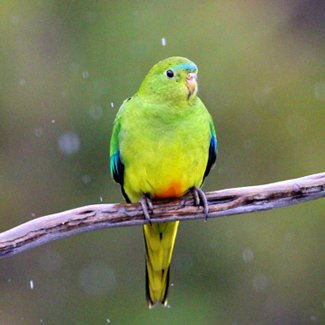Plight of the orange-bellied parrot

With fewer than 50 individuals remaining in the wild, spotting this parrot is a rare treat, finds photographer Inger Vandyke.
ONE A WINDSWEPT walking trail in Tasmaniaʼs south-west, I witnessed a tiny flash of sapphire, gold, green and orange flit across the path in front of me, the brief burst of colour conspicuous against a landscape of fatigue green.
My brain, still addled from the bumpy small aircraft flight over the Arthurs and Bathurst Harbour, thought it was a mirage, until I realised that I was staring at one of the worldʼs rarest birds, the critically endangered orange-bellied parrot (Neophema chrysogaster).
An isolated mid-summer sleet storm washed over Melaleuca, the last stronghold of these tiny, rainbow-hued parrots. So I took shelter under an outcrop of wet sclerophyll, where I watched the bird preen after it landed in a dead tree nearby.
The majority of orange-bellied parrots at Melaleuca thrive in the grounds of Deny Kingʼs old house on the banks of the tannin stained Melaleuca Inlet. A resident of Melaleuca for 45 years, Deny, now deceased, was a keen observer of wildlife and a volunteer weather observer for the Bureau of Meteorology. His home is now heritage listed and, as a part of his legacy to the animals he observed, a number of purpose-built hollow logs that Deny constructed are still being used by the birds today to nest.
Orange-bellied parrots now sit on an evolutionary knife edge. Numbering fewer than 50 individuals in the wild, they have suffered a catastrophic decline. Each winter, as these tiny parrots leave the relative safety of their home in Melaleuca to migrate north across Bass Strait, they face increasing difficulty at their destination. Burgeoning coastal developments are swallowing up great tracts of salt marsh, the traditional foraging ground of the parrots. The construction of wind farms in their traditional flight paths creates an additional peril.
Captive breeding programs at Healesville Sanctuary in Victoria, Adelaide Zoo and Taroona in Tasmania represent the last hope for parrots. A dwindling number of wild birds translates into a waning genetic pool so each year, captive bred birds from these programs are released to join the remnant wild population to secure a greater genetic diversity.
During this summer, orange-bellied parrots held their own at Melaleuca. Nesting females produced 12 new chicks, the same number as the previous breeding season. However, these twelve chicks represent around 25 per cent of the total wild population so the pressure for scientists working in the field with the parrots has intensified.
Without careful monitoring, orange-bellied parrots could face extinction within four to five years.
Communing with an animal as rare as this is a profound experience. As I sat watching two young birds pick at seeds left out on their feeding tray by volunteers, I suddenly realised that the weight of a species was resting on their shoulders. Meanwhile, as a light, misty fog swirled through Melaleuca the shrill buzz of their fellow offspring echoed in the nearby trees.
Orange-bellied parrots have serenaded the forests of Melaleuca for hundreds of years. Hopefully they will continue to sing for as long as conservation efforts and science can offer them a stage.
RELATED STORIES

